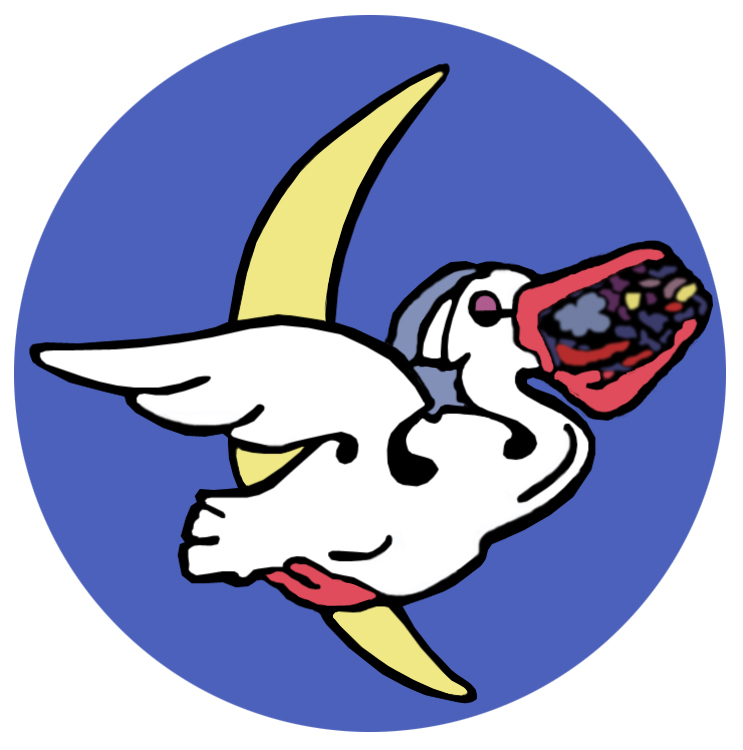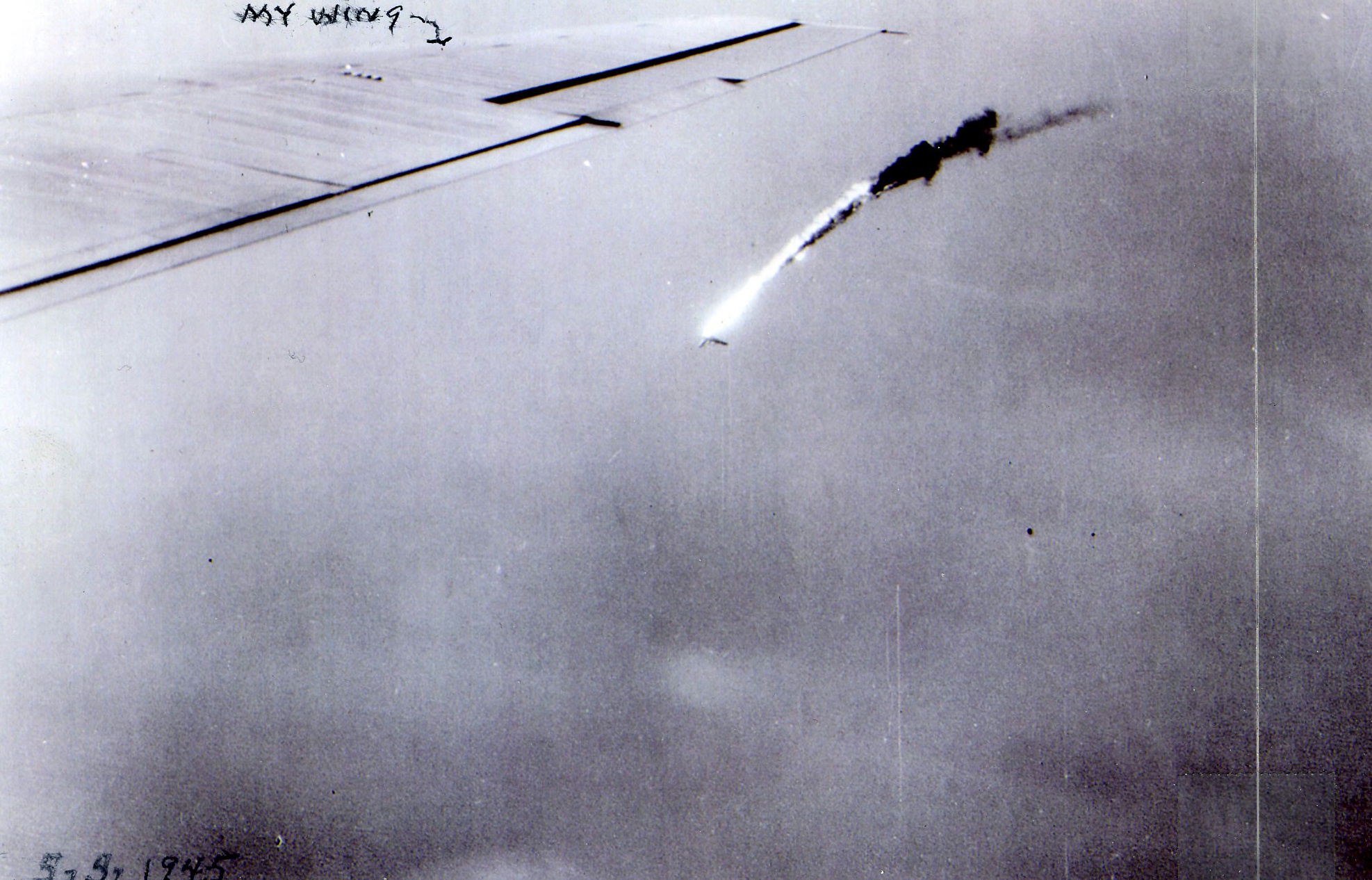In March 1945 the U.S. invaded the island of Okinawa in what became one of the most bitterly fought campaigns of the war. The Japanese went all out in an attempt to defeat the U.S. forces. One of their most devastating tactics was the use of Kamikaze planes, suicide flights in which a Japanese pilot flew his bomb-loaded plane into one of the U.S. warships supporting the invasion. These attacks sank or severely damaged many U.S. ships while killing nearly 5,000 sailors and wounding another 5,000. In an effort to stop these attacks, the B-29 bombers of the U.S. 20th Air Force, which had been bombing factories and industrial targets in Japan, were diverted to bombing the Japanese airfields from which the Kamikaze planes left the ground.
On May 4 and May 5, 1945 13 planes of the 29th Bomb Group, 20th Air Force, based on Guam in the Mariana Islands, flew a bombing mission against such an airfield at Tachiarai, a city located in the middle of the Japanese home island of Kyushu. Among the planes on this flight was one commanded by Lt. Allie Thacker (I was the navigator on Thacker's plane) and another commanded by Lt. Frank (Red) Klassen. Thacker and Klassen were very close friends, having been together throughout their flight training, and they had married girls who were very close friends. The crews of the two planes lived in the same Quonset hut and were almost family. Here is part of a letter I wrote my mother prior to the start of this mission, which would be our 13th mission. We weren't superstitious, but...
"Dear Mother:
Guess what? Yep, another mission! And you know what the number is! Only we're calling it 12b! Can't say that no good number! It looks as if we'd catch a lot of fighters up there tomorrow, too. Hope not, but that's the way it looks. I'm glad we're flying these missions this fast, since it does keep us busy and we'll get home that much sooner. We heard a rumor today that we had to go a minimum of 25 and a maximum of 35 missions, which means that we'll probably go about 30, maybe a few more, not much chance of less. It depends a good deal upon replacements and the way things go. Right now they're using all their veteran crews because of the missions. How long it will keep up I don't know, but the newer crews aren't flying too much."
(Here's the end of the letter...written after we got back.)
"That damned 13! I'm glad we never got to fly that one again. It ranks right up with Nagoya (note added: Nagoya had been a difficult, earlier mission on which we lost our first two planes) and just as Nagoya, I hope we never have to go back there again. It was bad, plenty bad. We had to go inland one long ways to hit the target. Fighters picked us up right at the coast and followed us all the way to the target and back to the coast. Hit us, too. Our plane looks like a sieve, no fooling. There are two huge holes in the left wing about a foot in diameter. The elevator on tail is shot up and there's a big bite out of it. The tail gunner got 10 bullets right along his window. He's the luckiest boy on the field today. Didn't even get touched. One gunner was cut by glass when a piece of flak hit his blister, but he's ok. Flak splattered our bomb bays and there are 50 or 60 holes along the bomb bays. But not a person in the plane was hurt outside of the gunner and he didn't even have to put iodine on his cut it was so small. One of our planes was hit pretty bad, so we dropped back to help him keep fighters off him. We drove the fighters away, but it didn't do any good. The squadron was hit pretty hard again yesterday. It just seems that we go along ok for a few missions, then bang--we're hit hard again. But at least most of the fellows yesterday got out of their planes. Don't let anyone fool you, though. Those Japs are plenty good. I'll be right in the front row at church again this morning. Incidentally, we'll be resting for a few days also, since it'll take a while to get our plane ready again. We may fly somebody's plane, but I doubt it."
More about the plane that dropped back: It was a little behind us in the formation going over the target. A Japanese fighter hit it in the right wing, disabling one engine and starting a fire in the wing which continued to burn. The plane dropped out of formation and started lagging behind. One of the gunners in the rear of our plane called out over the intercom, "Klassen's been hit and is on fire." Now the U.S. Navy had assigned submarines to lie off the coast of Japan at pre-assigned locations which were given to the air crews. If a plane had to ditch, it would try to do so close to one of the subs so the sub could pick up the crew. It was a great morale booster for us and many lives were saved by these subs. On this mission, one of those subs was a short distance off the Japanese coast, so there was a chance for this crew if they could make it to the sub before the wing burned off. But the fighters were swarming around it, so we decided to drop back to help fend off the fighters. For some reason the Jap fighters would almost never follow you off the coast, even if your plane was crippled.
Now an ironic thing happened. The plane that had been hit was NOT Klassen's but that of a crew that had just joined our squadron, Ralph Miller. When we dropped back, the crew of Klassen's plane saw it, thought we were in trouble, and so they dropped back to give us some help! One of our gunners saw Klassen's plane approaching us from a distance, thought it was a Jap fighter coming in, and started firing at it. (Note added: It might seem that it would be hard to mistake a B-29 for a Japanese fighter, but in the heat of battle it was possible to do so.) Within a few seconds I recognized it as a B-29 and yelled over the intercom to stop firing. Fortunately the plane was not hit. By this time we were over the ocean and the Japanese fighters turned back. However, the fire in the wing of Miller's plane had continued to burn and within a few minutes the wing broke off and the plane spiraled into the ocean. We saw no parachutes emerge from the plane.
On each mission we carried a camera to record events, and as Miller's plane was going down one of our gunners snapped a picture. I'm enclosing a copy of it. This picture later appeared in an edition of "LIFE" magazine. Later our Aircraft Commander, Thacker, was awarded the Silver Star in Recognition of our action (click here to read the General Order for Allie A. Thacker's Silver Star).
Several years after the war, a Web site devoted to the 20th Air Force was started by a woman named Sallyann Wagoner. Her father-in-law had been a crew member on a B-29 and she wanted to recognize what he had done during the war. Through Sallyann's Web site (http://home.att.net/~sallyann2/b29.html--no longer functioning) I became acquainted with another B-29 crew member by the name of Raymond "Hap" Halloran who had been shot down over Tokyo on January 27, 1945 and had been a prisoner of war in Japan until the end of the war. Hap's story is fascinating and shocking. You can read it at a Web site he has started: www.haphalloran.com/.
After the war, Hap went to Japan several times and met many Japanese who had been in the war, including the Japanese pilot who had shot down his B-29. One day, on Sallyann's site, Hap posted an e-mail he had received from one of his Japanese friends asking Hap for information about the bombing of Tachiarai on May 4-5. I replied to Hap that we had been on that mission and he so informed his Japanese friend. Hap send me a copy of his friend's subsequent reply:
"A mission over Tachiarai was launched on 5 May. On 5 May three B-29s were lost. It is considered that all of the three B-29s were shot down by George fighters from Omura. (Note: Japanese planes were given people's names, male names for fighters, i.e. George, and female names for bombers, i.e. Betty). One plane crashed near Usa in Oita Pref. Another plane crashed in the sea after being escorted by two B-29s after it was heavily damaged. Details of the other one are unknown. George fighter pilots were greatly impressed with the brave escorting act of two B-29s, as I said before.
In addition to Miller's plane, another 29th Bomb Group plane shot down that day was one commanded by Marvin Watkins. All of the crew members of Watkins' plane escaped, parachuted safely to the ground, and were, of course, captured by the Japanese. However, only Watkins survived prison camp and was freed on August 25, 1945. The other 10 crew members died in prison camps.
I flew my last mission (another rough one) on July 25, 1945. The next day our crew was sent to Hawail for R & R (rest and recuperation) and then back to the states, landing in San Francisco on the day the first A-Bomb was dropped. We were given leaves to go home and I finally saw my fiancee again on August 14, the day Japan surrendered. What a celebration! We were married on September 5, 1945. We had a three month honeymoon, courtesy of Uncle Sam. I was first sent to Greensboro, N.C. for assignment. There I was given 30 days to report to my next base, Colorado Springs. After three weeks there with no assigned duty, I was sent to Denver where I was discharged on Thanksgiving Day, 1945, the end of almost three years that I would not want to repeat, but an experience I do not regret having.
Note: Additional narrative about the remainder of this mission can be accessed by clicking on the first link at the bottom of the home page ("more information about the 6th Bomb Squardron").




